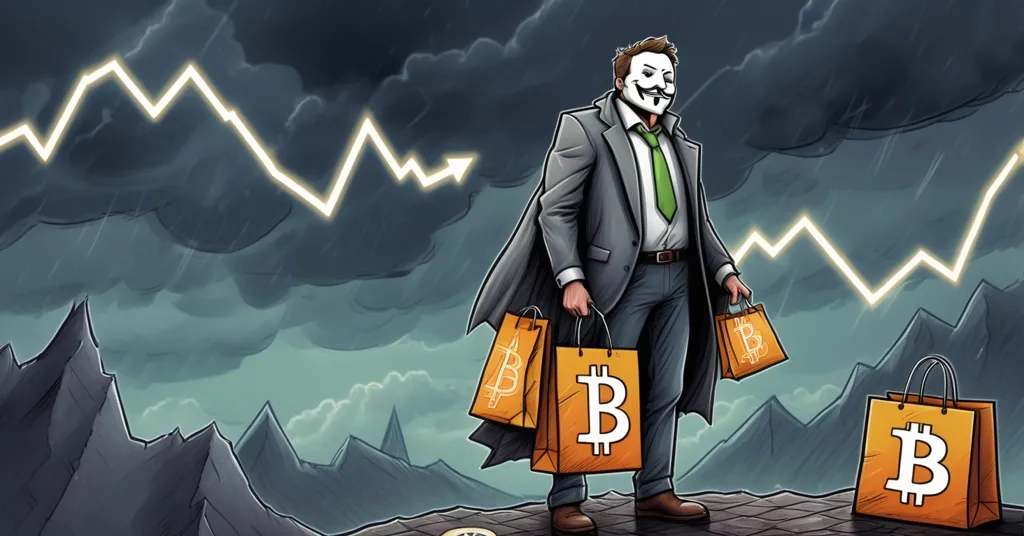Bitcoin Crash 2025: Robert Kiyosaki Hopes for Dip to Buy More BTC

Bitcoin Crash 2025: Why Robert Kiyosaki Is Praying for a Dip to Buy More
Bitcoin’s relentless rollercoaster has struck again, soaring to a mind-blowing $110,600 before stumbling 1.4% in just 48 hours, igniting a frenzy of crash predictions across social media and news outlets. Enter Robert Kiyosaki, the fiery author of Rich Dad Poor Dad, who’s not just shrugging off the doom and gloom—he’s openly wishing for a market nosedive to snag more BTC at fire-sale prices.
- Bitcoin peaks at $110,600, slips 1.4% in two days, fueling crash hysteria.
- Kiyosaki trashes clickbait fear-mongers, hopes for a dip to stack more BTC.
- His audacious targets: $200,000 by end of 2025, $1 million in five years.
Kiyosaki’s Crash Wish: Genius or Reckless Gamble?
Let’s cut to the chase: Bitcoin’s price swings are nothing new, yet they still manage to send half the market into a tailspin every time. After touching $110,600 intra-week, a measly 1.4% dip had clickbait hacks screaming “the end is nigh” on every corner of the internet. Robert Kiyosaki, however, isn’t buying the panic. On July 5, 2025, he unleashed a scathing rant on Twitter (or X, if you must), tearing into what he calls “losers” peddling fear for clicks. You can catch his unfiltered thoughts on platforms like X.
“CLICK BAIT Losers keeps warning of a Bitcoin crash. They want to frighten off the speculators. I hope Bitcoin crashes. I will only buy more.”
His point is brutal but clear: these sensationalist headlines aren’t about informing—they’re about manipulating. They spook long-term investors into doubting their convictions and push short-term traders to dump their holdings at the worst possible moment. Kiyosaki, who’s already shelled out for Bitcoin above $100,000 per coin, sees a crash not as a catastrophe but as a clearance sale. And he’s not just talking the talk. Earlier, on April 20, 2025, with BTC at $84,000, he predicted a surge to $180,000–$200,000 by year-end. Now, he’s upped the ante, forecasting a staggering $1 million within five years. Is this blind optimism or calculated boldness? The man behind Rich Dad Poor Dad has built a career on challenging financial norms, often framing assets like Bitcoin as hedges against inflation and economic rot—much like gold or silver. For more on his financial philosophy, check out his background on Wikipedia. For him, dips are just stepping stones to generational wealth.
Bitcoin 101: Decoding the Volatility Beast
For those just stepping into the crypto swamp, let’s break down the basics. Bitcoin (BTC), launched in 2009 by the mysterious Satoshi Nakamoto, is the granddaddy of cryptocurrencies. It runs on a decentralized blockchain—a tamper-proof digital ledger spread across thousands of computers worldwide, cutting out banks and governments. With a hard cap of 21 million coins, its scarcity is a core driver of value as demand spikes. Volatility, though? That’s the wild card. We’re talking price jumps or drops of thousands of dollars in hours, fueled by everything from whale trades (big players moving massive amounts) to regulatory whispers or even a rogue tweet. A “dip” is just a fancy way of saying the price dropped temporarily, while “hodlers”—a playful misspelling of “holders”—are those who cling to their BTC through thick and thin, often mocking panic sellers. If Bitcoin’s price chart were a theme park ride, most retail investors would’ve lost their lunch by now.
Volatility: Bitcoin’s Oldest Frenemy
Bitcoin’s recent stumble from $110,600 isn’t a glitch; it’s the norm. Historical data screams this loud and clear—every bull run comes with gut-punch corrections of 15% or more. A 10% pullback from these heights, as some analysts note, is barely a blip for anyone who’s been in the game longer than a week. Look at 2017: BTC skyrocketed to $20,000, then cratered 70% in 2018. Or 2021, when it hit $69,000 only to bleed down to $30,000 in months. These swings often shred retail investors—folks like you and me without deep pockets—who sell at the bottom, locking in losses while whales and institutions scoop up the scraps. CoinDesk’s Nathan Batchelor pegs a near-term floor around $90,000 if momentum fades, with a weekly close below $99,000 potentially signaling a nastier drop to $82,000. Yet, technical indicators like the DeMark TD Sequential hint at bullish setups, targeting $119,270 if prices hold above $107,300. For deeper insights into these trends, see the latest Bitcoin market projections for 2025. Translation? The market’s a coin toss, but history favors the patient.
Buying the Dip: Kiyosaki’s Play, But at What Cost?
Kiyosaki’s strategy of buying on dips sounds sexy—who doesn’t love a discount?—but it’s a high-stakes game not built for everyone. First, you need cash sitting idle, ready to pounce the second prices tank. Second, you need nerves of titanium. Imagine buying at $90,000, thinking you’ve outsmarted the market, only to watch it spiral to $70,000 on some random FUD (fear, uncertainty, doubt) like a regulatory crackdown rumor. Data from past cycles shows a harsh truth: while dips often recover—BTC bounced from $3,000 in 2018 to $69,000 by 2021—not everyone survives the wait. Some 20% of investors who bought dips during the 2021 crash sold at a loss within six months, per Glassnode analytics. Risk tolerance isn’t a cute catchphrase; it’s the line between profit and pain. Kiyosaki’s got the capital and the conviction. Do you? For community takes on his crash predictions, browse discussions on Reddit.
Zooming Out: What’s Driving Bitcoin in 2025?
Beyond the daily price drama, 2025 is shaping up as a pivotal year for Bitcoin. Analysts project a climb to $130,000–$150,000 by mid-year, propped up by seismic shifts. For a detailed breakdown, take a look at forecasts on potential price targets in Forbes. For starters, clearer U.S. regulatory frameworks could finally stop the whiplash of “is it a security or not?” debates, enticing more institutions to dive in. Hedge funds and corporations are already piling up BTC—think MicroStrategy, but on steroids. Then there’s talk of a “Strategic Bitcoin Reserve” under the Trump administration, a wild-card idea to treat BTC like a national asset akin to oil reserves. If it happens, it could moon prices; if it stalls in political mud, expect a Q1 pullback. Macro factors add fuel: a weakening U.S. dollar makes Bitcoin a hotter hedge, while “America First” policy vibes boost optimism for decentralized alternatives to fiat. Michael Saylor, ex-CEO of MicroStrategy, doubles down on this, touting Bitcoin’s 21 million cap and swelling global demand as unstoppable forces. His $1 million target matches Kiyosaki’s, but with a corporate strategist’s lens. Hear more from Saylor himself in this recent Bloomberg interview.
Clickbait Chaos: Crypto Media’s Dirty Little Secret
Let’s not mince words: the crypto media landscape is often a cesspool of clickbait garbage, and Kiyosaki’s rage isn’t misplaced. Headlines like “Bitcoin Dead After 5% Drop!” or “Crash Incoming, Sell Now!” aren’t journalism—they’re psychological warfare. They prey on retail investors’ FOMO and fear, nudging them to make rash moves while ad revenue rolls in. Studies from 2023 showed over 60% of crypto news shared on social platforms exaggerated volatility for engagement, per Chainalysis. The result? Small-time holders sell low, whales buy cheap, and the cycle repeats. It’s not just sloppy reporting; it’s damn near predatory. Until the community demands better—or just ignores the noise—expect every hiccup to be spun as Armageddon. For a closer look at Kiyosaki’s take on market crashes, read this analysis on Bitcoinist.
Devil’s Advocate: Can Bitcoin Ever Be Real Money?
Here’s the uncomfortable flip side to Kiyosaki’s gospel: if Bitcoin’s volatility stays this savage, can it truly become the “future of money” he envisions? A store of value, sure—its scarcity and decentralization make it a digital gold for some. But a currency for daily use? Good luck buying coffee when the price yo-yos $10,000 in a week. Critics argue Bitcoin’s wild swings undermine its utility as a stable medium of exchange, a core trait of money. Even with scaling solutions like the Lightning Network (a layer on Bitcoin for faster, cheaper transactions), mass adoption as a payment tool feels far off while volatility rules. Kiyosaki might counter that crashes are just growing pains, weeding out weak hands and accelerating the shift to a decentralized economy. It’s an effective accelerationist take—e/acc in full force—but it’s not a universal truth. Curious about why he might want a crash? Explore perspectives on Quora.
Beyond Bitcoin: The Wider Decentralized Revolution
While I lean toward Bitcoin maximalism—BTC as the ultimate decentralized kingpin—let’s not pretend it’s the only player. Altcoins and other blockchains like Ethereum power niches Bitcoin doesn’t touch, like decentralized finance (DeFi) or smart contracts (self-executing agreements coded on-chain). During crashes, these assets often bleed harder than BTC, reinforcing its relative strength, but they also drive innovation that benefits the whole space. Competition isn’t a threat; it’s a catalyst, pushing Bitcoin to evolve while filling gaps it can’t or shouldn’t. Saylor himself admits this ecosystem rivalry fuels broader adoption. The financial revolution isn’t a solo act—it’s a chaotic symphony. For more on how Kiyosaki’s price targets influence market sentiment, see this report on AInvest.
Key Takeaways and Burning Questions
- What’s Robert Kiyosaki’s stance on Bitcoin crash predictions?
He calls them clickbait trash designed to scare investors, hoping for a crash himself to buy more BTC at a discount. - Why does he slam sensationalist headlines?
Kiyosaki sees them as cheap ploys for clicks, not facts, that spook long-term holders and trigger premature selling by short-term traders. - What are his Bitcoin price predictions?
He’s betting on $200,000 by the end of 2025 and a staggering $1 million within five years, showcasing unshakable bullishness. - How do analysts interpret Bitcoin’s recent price swings?
Many view a 10% pullback from $110,600 as routine, citing historical corrections of 15% or more that often shake out retail investors. - What risks come with buying Bitcoin on dips?
It demands spare cash and ironclad risk tolerance, as deeper drops could trap buyers if the market doesn’t rebound soon. - How does Michael Saylor’s view align with Kiyosaki’s?
Saylor echoes a long-term bullish outlook, highlighting Bitcoin’s fixed 21 million supply and rising demand as reasons to hold through turbulence. - What do past Bitcoin crashes tell us about today’s market?
History shows brutal corrections (like 70% in 2018) are normal in bull cycles, suggesting current volatility is just another hurdle for the patient. - What could a U.S. Strategic Bitcoin Reserve mean for prices?
If enacted, it could skyrocket BTC by legitimizing it as a national asset; if delayed by politics, it might dampen short-term momentum.



